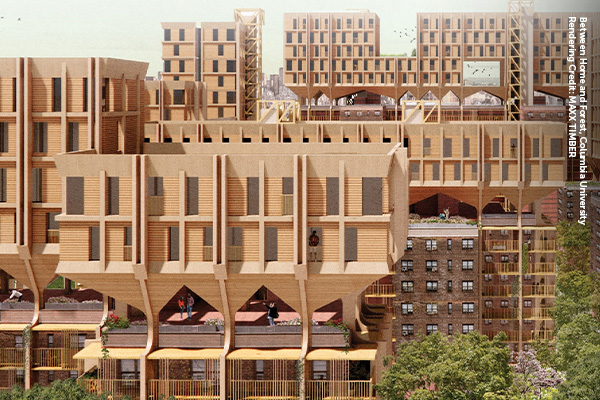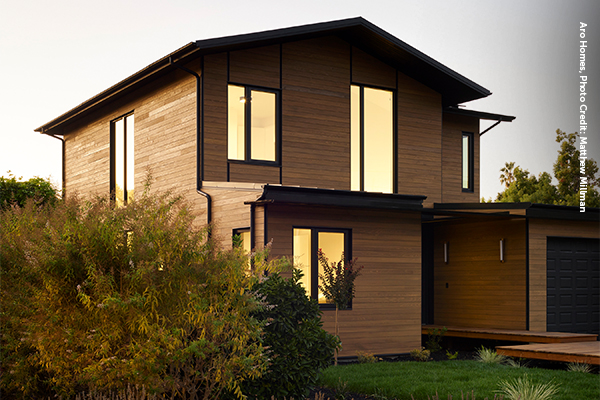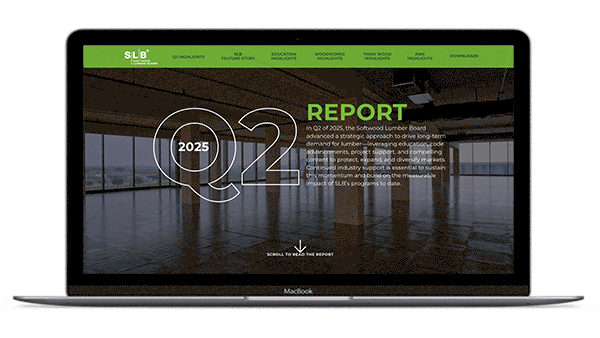HIGHLIGHTS
PROGRAM UPDATES
Student Competitions Inspire the Next Generation of Designers The AWC’s Comprehensive Engagement Protects Lumber Industry on Wildfire Issues WoodWorks’ Mid-Year Report Shows Gains Toward Long-Term Market Growth Think Wood’s Residential Resources Demonstrate Lumber’s Applications—in Homes and BeyondProgram Updates
Student Competitions Inspire the Next Generation of Designers

What if the first time a future architect designs attainable housing, a lumber-based solution isn’t an afterthought—but the starting point? That idea drives Timber in the City: Urban Habitats, now launching its sixth cycle in partnership with the Association of Collegiate Schools of Architecture (ACSA).
This national competition continues to be one of SLB Education’s most impactful platforms for engaging future architects, showcasing lumber’s possibilities and embedding the material into the thinking of tomorrow’s design leaders. Over five cycles and 10 years, nearly 3,500 students from 95 unique schools—representing two-thirds of all accredited architecture programs in North America—have participated. Each design brief challenges students to rethink urban housing, resilience, and sustainability, making lumber central to solutions for pressing societal needs. This year’s competition focuses on attainable housing at three different scales, a format designed to appeal broadly to faculty and integrate seamlessly into architectural curricula.
Academic competitions, part of the SLB’s broader strategy to engage postsecondary students, reinforce a critical principle of the Education program: the greatest leverage point is upstream of practice, with students and their professors. Architects and engineers who learn about wood early will be less likely to avoid specifying it later. By engaging them in their formative years, we ensure they leave school already familiar with lumber’s properties, its versatility and beauty, and its economic and sustainable benefits.
Other material industries have long recognized the power of student engagement—the American Institute of Steel Construction (AISC) has sponsored its Steel Competition annually for 25 years—so the SLB’s investment ensures that wood not only keeps pace but also stands out with design challenges rooted in urgency and possibility.
Competitions and experiences that nurture students’ instinct toward natural materials—and arm them with the knowledge to overcome bias—are more than academic exercises. They are catalysts for change, equipping the next generation of AEC professionals to imagine and realize lumber as a primary solution in the built environment. Without them, the lumber industry would lose one of its most powerful levers for long-term growth. With them, the industry’s investment compounds—expanding the pipeline of emerging professionals with knowledge of, and enthusiasm for, lumber solutions.
The AWC’s Comprehensive Engagement Protects Lumber Industry on Wildfire Issues
The AWC’s swift and effective actions following California’s tragic fires earlier this year underscore years of preparation and collaboration. The AWC is well equipped and able to draw on testing and data, as well as recently adopted codes, to help prevent unwarranted bans of lumber. As wildfire issues, including wildland-urban interface, expand to other regions of the country, the AWC will continue these efforts in earnest.
Over the past few years, the AWC has conducted a series of WUI fire tests, using widely recognized performance-based protocols to demonstrate the fire resistance of wood structures. The data from these tests has been an important tool that demonstrates the safety, code compliance and fire resistance of wood products.
The AWC’s ability to respond quickly in California was built on multiple years of engagement with the state’s code development process and fire service. The AWC’s work and education around the California WUI code and strong relationship with the fire service meant that many building and fire service officials already knew of the state’s new WUI code and were able to speak to the importance of building to code instead of pressing for unwarranted material bans.
Beyond California, AWC has also been deeply involved in the development of the 2027 International Wildland Urban Interface Code and the International Code Council 605 Standard for Residential Construction in Regions with Wildfire Hazard, both of which will have significant implications for building code requirements in WUI zones. The AWC’s approach to these processes is to actively support proven techniques, such as maintaining adequate defensible space, providing for multiple fire zones, and performance-based materials testing that ensure wood products are not unfairly treated.
To further align the sector on these complex issues, the AWC and the Working Forests Initiative have released a new wildfire messaging guide, Wildfire Mitigation: Strategy and Values in Action. By keeping the sector aligned, the guide helps protect credibility, reinforce key messages, and amplifies the industry’s voice in wildfire policy and public conversations. Download the guide here.
WoodWorks’ Mid-Year Report Shows Gains Toward Long-Term Market Growth
Among SLB-funded programs, WoodWorks has the unique mission of working directly with developers and design/construction teams to foster a shift toward wood solutions. Read WoodWorks’ Mid-Year Report to learn how the strategic combination of project support, education, and technical resources is enabling practitioners to expand their use of wood in commercial and multifamily buildings across the United States.
Think Wood’s Residential Resources Demonstrate Lumber’s Applications—in Homes and Beyond

Think Wood’s resources in the single-family residential market play a vital role in protecting and growing market share for lumber. Case studies help residential contractors visualize additional uses for wood products in homes beyond framing and decking. They also help commercial audiences understand the applications possible with wood that they can use in their own projects, as single-family homes have long been considered a laboratory for design innovation in the building industry.
Residential case studies are also some of Think Wood’s most popular stories across all audience sectors, helping to increase engagement. That engagement translates to market impact: A survey showed that 72% of highly engaged users (+11% from last year) said that interaction with Think Wood increased their likelihood of specifying wood.
Recent stories underscore the breadth of Think Wood’s coverage. A contemporary prefab light-frame model designed for tech startup Aro Homes by renowned architecture firm Olson Kundig highlights how factory-based construction can reduce project timelines and embodied carbon. A profile of nArchitects’ CLT House showcases both innovative uses of CLT and the beauty of exposed wood on the interior and exterior of the home. And a list of five beautiful wooden waterfront homes provides inspiration for how builders can use a variety of lumber products to create stunning visual appeal.
Together, these resources don’t just spotlight residential design—they also strengthen lumber’s position across all building types by reinforcing its versatility, sustainability, and aesthetic appeal.
Spotlight
The SLB Backs Global Framework to Increase Lumber Demand
Built by Nature’s Principles for Responsible Timber Construction is a first-of-its-kind global framework to ensure building with wood benefits climate, nature, and people. The Principles provide a clear and structured foundation that cities and governments can use to integrate timber construction into climate strategies and building codes.
“Lumber stands at the heart of building a low-carbon, circular economy,” says SLB President and CEO Cees de Jager, who endorsed the Principles on behalf of the SLB. “These Principles directly support our mission: replacing fossil-based materials with sustainable wood solutions that drive innovation, market diversification, and economic growth. Responsible construction with lumber delivers more than environmental benefits—it’s an intelligent, scalable pathway to building the accessible and affordable spaces where we live, work, and play across America and around the world.”
The SLB joins the AWC and more than 200 organizations ranging from forest managers and manufacturers to investors, architects, and engineers in endorsing the Principles, signaling growing momentum for wood construction as a low-carbon building solution. Learn more about the Principles and see the full list of endorsers here.
Industry Resources
FEA's Housing Dashboard
FEA’s Housing Dashboard
These housing dashboards are provided compliments of Forest Economic Advisors (FEA).
View the August Housing Dashboard
View the September Housing Dashboard
Virginia Tech's Monthly Housing Report
This monthly housing commentary report is a free service of Virginia Tech and is intended to help one gauge future business activity in the U.S. housing market.
July 2025 Reports (released in September 2025)
Part A: July Housing Commentary
Part B: July Economic Conditions




